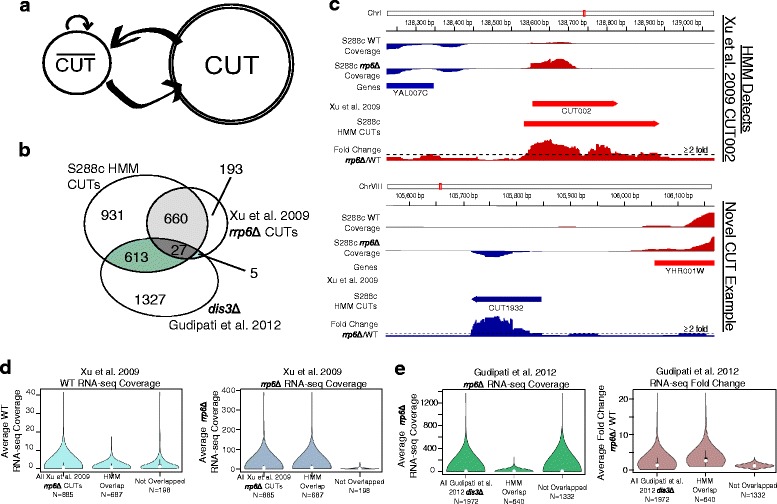Fig. 1.

10-state HMM identifies CUTs de novo from RNA-seq. a Explicit duration HMM describing regions which have little to no fold change and regions of elevated fold change in rrp6Δ relative to WT (CUT) as calculated from two biological replicates. b Venn diagram showing overlap between S288c CUTs annotations as determined by our HMM, rrp6Δ CUTs from Xu et al. [11], and dis3Δ transcripts from Gudipati et al. [31]. Minimum overlap of 25 % by length between annotations is required for positive matches. c IGV [53, 54] snapshots showing two examples of CUTs detected in S288c by our HMM. Top example shows previously identified Xu et al. CUT002 which is also identified by our HMM. Bottom example shows a novel CUT identified in this study. For each example, tracks are S288c WT RNA-seq coverage, S288c rrp6Δ RNA-seq coverage, annotated genes, Xu et al. [11] annotated CUTs, CUTs called by our HMM, and rrp6Δ/WT fold change within the region. Strand-specific data is color coded with Watson/plus strand in red and Crick/minus strand in blue. d Violin plots comparing the average S288c RNA-seq WT coverage and rrp6Δ/WT fold change from two biological replicates for all 885 possible Xu et al. [11] CUTs, the 687 CUTs overlapped by CUTs detected by our HMM, and the 198 remaining CUTs not overlapped by CUTs detected by our HMM. The Xu et al. [11] CUTs not identified in this study are presumably missed due to lack of stabilization in rrp6Δ. e Violin plots comparing the average S288c RNA-seq rrp6Δ and rrp6Δ/WT fold change from two biological replicates for all 1972 possible Gudipati et al. [31], the 640 transcripts overlapped by CUTs detected by our HMM, and the 1332 remaining transcripts not overlapped by CUTs detected by our HMM. The dis3Δ transcripts missed in previous rrp6Δ only, tiling array studies are presumably missed to limitations in tiling array sensitivity
